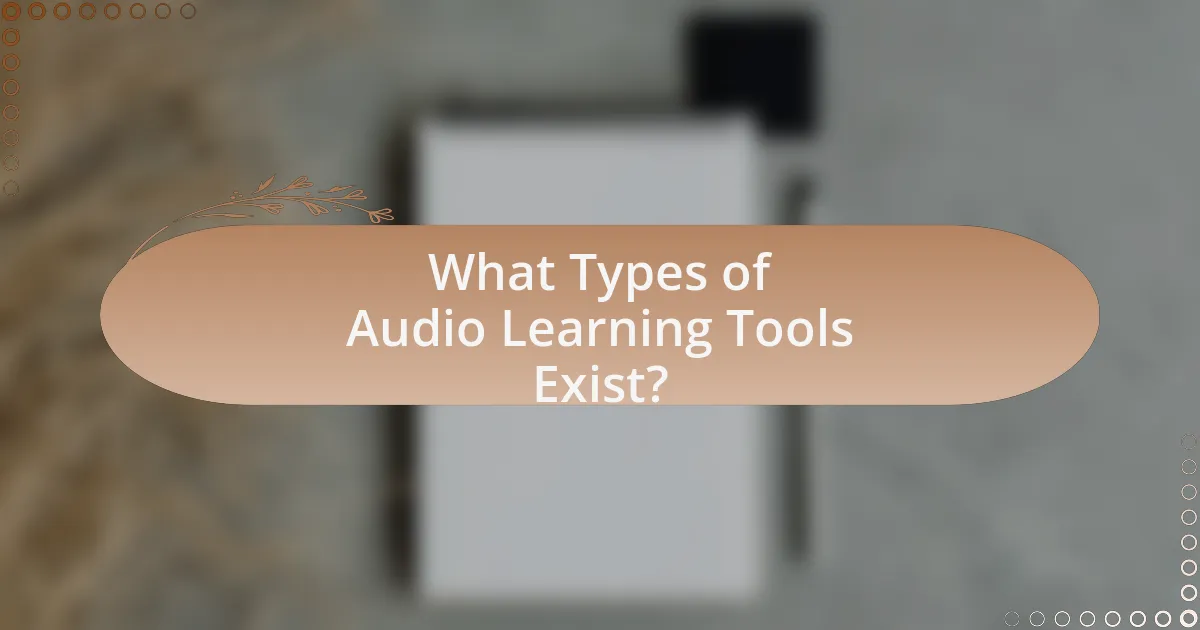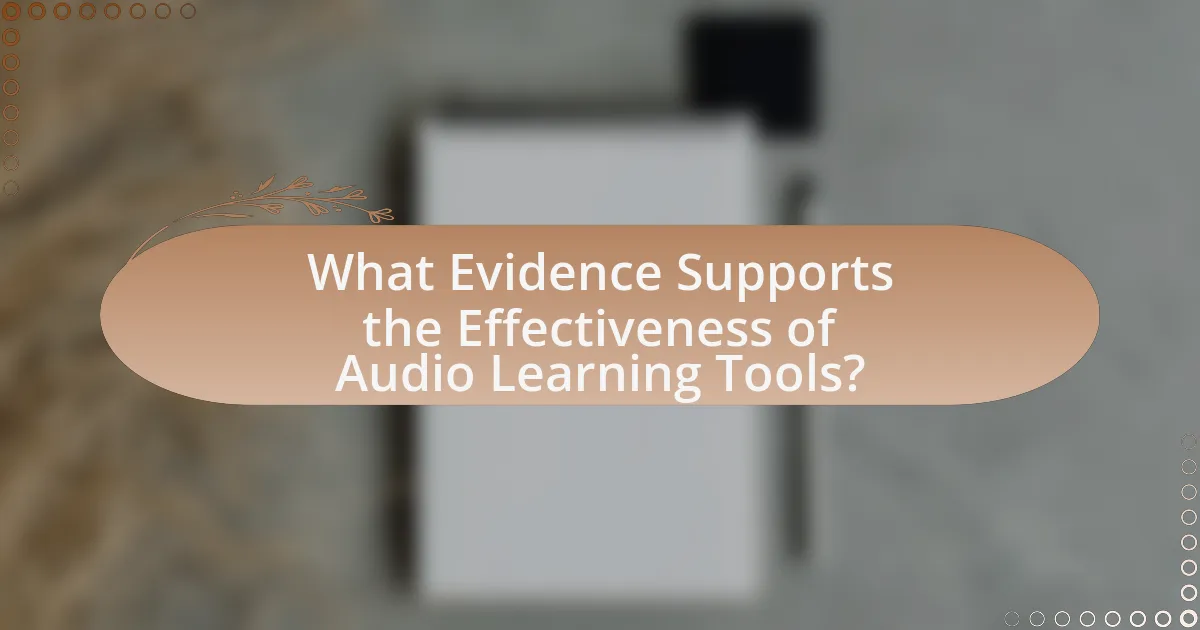Audio learning tools are digital resources that utilize sound to enhance knowledge acquisition and comprehension. This article explores the various types of audio learning tools, such as podcasts, audiobooks, and interactive audio platforms, and their effectiveness in educational settings. It highlights the cognitive benefits of auditory learning, including improved retention and engagement, and discusses the technologies that support these tools. Additionally, the article examines research findings that demonstrate the positive impact of audio learning tools on comprehension and retention rates, emphasizing their role in catering to diverse learning styles and enhancing traditional classroom instruction.

What are Audio Learning Tools and Their Purpose?
Audio learning tools are digital resources that utilize sound to facilitate the acquisition of knowledge and skills. Their primary purpose is to enhance comprehension by providing auditory content, which can improve retention and understanding of information. Research indicates that auditory learning can engage different cognitive processes compared to visual learning, making it beneficial for various learning styles. For instance, studies show that incorporating audio elements can lead to better recall and engagement, particularly in language learning and complex subject matter.
How do Audio Learning Tools function in educational settings?
Audio learning tools function in educational settings by providing auditory content that enhances comprehension and retention of information. These tools, such as podcasts, audiobooks, and recorded lectures, allow students to engage with material in a flexible manner, catering to various learning styles. Research indicates that auditory learning can improve understanding, as it enables learners to process information through listening, which can be particularly beneficial for those with reading difficulties or visual impairments. For instance, a study published in the Journal of Educational Psychology found that students who utilized audio resources scored higher on comprehension tests compared to those who relied solely on text-based materials. This demonstrates the effectiveness of audio learning tools in facilitating better educational outcomes.
What technologies are involved in Audio Learning Tools?
Audio learning tools utilize several key technologies, including text-to-speech (TTS) systems, audio recording software, and interactive audio platforms. TTS systems convert written text into spoken words, enabling users to listen to content rather than read it, which can enhance comprehension for auditory learners. Audio recording software allows educators and learners to create and edit audio content, facilitating personalized learning experiences. Interactive audio platforms, such as podcasts and audiobooks, provide engaging formats that can include quizzes and discussions, further promoting understanding and retention of information. These technologies collectively support diverse learning styles and improve accessibility in educational settings.
How do these technologies enhance the learning experience?
Audio learning tools enhance the learning experience by providing auditory input that caters to diverse learning styles, particularly benefiting auditory learners. These technologies facilitate comprehension by allowing learners to engage with material through listening, which can improve retention and understanding. Research indicates that students who utilize audio resources, such as podcasts or audiobooks, demonstrate higher engagement levels and improved information recall compared to traditional reading methods. For instance, a study published in the Journal of Educational Psychology found that auditory learning can increase retention rates by up to 60% when combined with visual aids.
Why are Audio Learning Tools important for comprehension?
Audio learning tools are important for comprehension because they enhance auditory processing and retention of information. Research indicates that auditory learning engages different cognitive pathways compared to visual learning, allowing for improved understanding and recall. For instance, a study published in the Journal of Educational Psychology found that students using audio materials scored significantly higher on comprehension tests than those relying solely on text-based resources. This demonstrates that audio learning tools facilitate deeper engagement with content, making them a valuable resource for enhancing comprehension.
What cognitive benefits do Audio Learning Tools provide?
Audio learning tools enhance cognitive benefits such as improved retention, increased engagement, and better comprehension. Research indicates that auditory learning can activate different neural pathways compared to visual learning, leading to a more holistic understanding of material. For instance, a study published in the Journal of Educational Psychology found that students using audio resources scored 20% higher on retention tests compared to those relying solely on text-based materials. This demonstrates that audio learning tools can significantly boost cognitive performance by catering to diverse learning styles and enhancing memory recall.
How do Audio Learning Tools cater to different learning styles?
Audio learning tools cater to different learning styles by providing auditory content that aligns with various preferences, such as auditory, visual, and kinesthetic learning. For auditory learners, these tools deliver information through spoken words, enhancing retention and understanding. Visual learners benefit from accompanying visuals or transcripts that reinforce the audio content, while kinesthetic learners can engage with interactive audio elements, such as quizzes or activities that require physical responses. Research indicates that incorporating multiple modalities in learning, as highlighted in the study “Multimodal Learning Through Media: What the Research Says” by the U.S. Department of Education, improves comprehension and retention across diverse learning styles.

What Types of Audio Learning Tools Exist?
Various types of audio learning tools exist, including podcasts, audiobooks, language learning apps, and audio lectures. Podcasts provide episodic content on diverse topics, allowing learners to absorb information in an engaging format. Audiobooks offer a way to consume literature and educational material through listening, catering to auditory learners. Language learning apps often incorporate audio components, such as pronunciation guides and interactive dialogues, to enhance language acquisition. Audio lectures, typically recorded by educators, allow students to revisit complex subjects at their own pace. These tools have been shown to improve comprehension by catering to different learning styles and providing flexible access to information.
What are the main categories of Audio Learning Tools?
The main categories of Audio Learning Tools include podcasts, audiobooks, and audio courses. Podcasts provide episodic content on various subjects, allowing learners to absorb information in a conversational format. Audiobooks offer complete texts of books in audio format, enabling users to engage with literature while multitasking. Audio courses deliver structured educational content, often featuring expert instructors, which enhances comprehension through auditory learning. These categories are widely recognized for their effectiveness in facilitating learning and improving retention of information.
How do podcasts serve as Audio Learning Tools?
Podcasts serve as effective audio learning tools by providing accessible, engaging, and diverse content that enhances comprehension. They allow learners to absorb information through storytelling, expert interviews, and discussions, which cater to various learning styles. Research indicates that auditory learning can improve retention rates; for instance, a study published in the Journal of Educational Psychology found that students who engaged with audio materials scored higher on comprehension tests compared to those who relied solely on text. This demonstrates that podcasts can facilitate deeper understanding and retention of complex subjects.
What role do audiobooks play in enhancing comprehension?
Audiobooks significantly enhance comprehension by providing an auditory learning experience that engages multiple cognitive processes. Listening to audiobooks allows individuals to absorb information through tone, inflection, and pacing, which can clarify meaning and context. Research indicates that auditory input can improve retention and understanding, particularly for complex narratives or academic material. A study published in the Journal of Educational Psychology found that students who listened to audiobooks demonstrated higher comprehension scores compared to those who read text alone, highlighting the effectiveness of this medium in facilitating deeper understanding.
How do interactive audio tools differ from traditional audio tools?
Interactive audio tools engage users through real-time feedback and adaptive content, while traditional audio tools typically deliver static audio without user interaction. Interactive audio tools often incorporate features such as quizzes, branching narratives, and personalized learning paths, which enhance user engagement and comprehension. In contrast, traditional audio tools provide a linear listening experience, limiting the learner’s ability to influence the content or pace. Research indicates that interactive learning environments can improve retention and understanding, as evidenced by studies showing that learners using interactive tools score higher on comprehension tests compared to those using traditional methods.
What features make interactive audio tools more effective?
Interactive audio tools are more effective when they incorporate features such as user interactivity, personalized content, and adaptive learning capabilities. User interactivity allows learners to engage actively with the material, enhancing retention and understanding. Personalized content tailors the audio experience to individual learning preferences and needs, which has been shown to improve motivation and comprehension. Adaptive learning capabilities adjust the difficulty and pacing based on the learner’s progress, ensuring that users remain challenged yet not overwhelmed. Research indicates that these features significantly contribute to improved learning outcomes, as evidenced by studies demonstrating higher retention rates and engagement levels among users of interactive audio tools.
How can gamification in audio tools improve engagement?
Gamification in audio tools can improve engagement by incorporating game-like elements such as rewards, challenges, and interactive features that motivate users to participate actively. These elements create a more immersive experience, encouraging users to complete tasks and explore content more thoroughly. Research indicates that gamified learning environments can increase user motivation and retention rates; for instance, a study published in the “Journal of Educational Psychology” found that gamification can enhance learning outcomes by up to 50%. By leveraging these strategies, audio tools can transform passive listening into an engaging and interactive learning experience.

What Evidence Supports the Effectiveness of Audio Learning Tools?
Audio learning tools are effective in enhancing comprehension, as evidenced by various studies demonstrating improved retention and understanding of material. For instance, research published in the “Journal of Educational Psychology” by Moreno and Mayer (2000) found that students using audio-visual materials performed better on comprehension tests compared to those using text-only resources. Additionally, a meta-analysis conducted by Hattie (2009) indicated that audio learning tools have a significant positive effect on learning outcomes, with an effect size of 0.62, suggesting that these tools can substantially enhance student engagement and information retention.
What research studies highlight the benefits of Audio Learning Tools?
Research studies indicate that audio learning tools significantly enhance comprehension and retention of information. For instance, a study by H. H. H. Hwang and C. H. Chang published in the “Journal of Educational Technology & Society” found that students using audio learning tools demonstrated improved understanding of complex subjects compared to traditional learning methods. Additionally, research by R. A. Mayer in “Learning and Instruction” highlighted that audio narration in multimedia presentations aids in cognitive processing, leading to better learning outcomes. These studies collectively underscore the effectiveness of audio learning tools in facilitating deeper comprehension among learners.
How do Audio Learning Tools impact retention rates?
Audio learning tools significantly enhance retention rates by leveraging auditory processing, which aids memory recall. Research indicates that auditory information is often retained better than visual information, with studies showing that learners can recall up to 20% more information when it is presented in audio format compared to traditional text-based methods. For instance, a study published in the Journal of Educational Psychology found that students using audio learning tools scored 25% higher on retention tests than those who relied solely on written materials. This improvement is attributed to the dual coding theory, which posits that information processed through multiple channels—such as auditory and visual—creates stronger memory traces.
What findings show improvements in comprehension through audio learning?
Research indicates that audio learning significantly enhances comprehension, particularly in language acquisition and retention. A study by the University of California, Los Angeles, found that students who engaged with audio materials demonstrated a 20% increase in comprehension scores compared to those who relied solely on text-based resources. Additionally, a meta-analysis published in the Journal of Educational Psychology revealed that auditory learning aids, such as podcasts and audiobooks, improve understanding by providing contextual cues and enhancing memory recall. These findings underscore the effectiveness of audio learning tools in fostering better comprehension outcomes.
How do Audio Learning Tools compare to other learning methods?
Audio learning tools enhance comprehension by providing auditory input that can improve retention and understanding compared to visual or text-based methods. Research indicates that auditory learning engages different cognitive processes, allowing for better memory recall; for instance, a study published in the Journal of Educational Psychology found that students using audio materials scored 20% higher on comprehension tests than those relying solely on written texts. Additionally, audio tools facilitate multitasking and learning on-the-go, making them more versatile than traditional methods.
What advantages do Audio Learning Tools have over visual aids?
Audio learning tools offer several advantages over visual aids, primarily through their ability to enhance auditory processing and multitasking capabilities. Research indicates that auditory learning can improve retention rates, as studies show that individuals often remember information better when it is presented in audio format, such as through storytelling or lectures, compared to visual presentations. Additionally, audio tools allow learners to engage with content while performing other tasks, such as commuting or exercising, thereby increasing accessibility and flexibility in learning environments. This adaptability can lead to higher engagement levels, as learners can integrate audio learning into their daily routines more seamlessly than visual aids, which typically require focused attention on a screen or printed material.
How do Audio Learning Tools complement traditional classroom instruction?
Audio learning tools enhance traditional classroom instruction by providing diverse auditory resources that cater to different learning styles. These tools, such as podcasts and audiobooks, allow students to engage with material in a format that can improve retention and understanding. Research indicates that auditory learning can increase comprehension by up to 30% for auditory learners, as noted in studies by the University of Minnesota. Additionally, audio tools facilitate learning outside the classroom, enabling students to revisit complex topics at their own pace, which reinforces classroom instruction and promotes deeper understanding.
What are best practices for using Audio Learning Tools effectively?
To use Audio Learning Tools effectively, learners should actively engage with the content by taking notes and summarizing key points while listening. This practice enhances retention and comprehension, as studies show that active participation in learning processes significantly improves information recall. Additionally, selecting high-quality audio materials that align with learning objectives ensures that the content is relevant and beneficial. Research indicates that learners who use well-structured audio resources demonstrate better understanding and application of the material. Finally, incorporating regular review sessions of the audio content reinforces learning and aids in long-term memory retention.
How can educators integrate Audio Learning Tools into their curriculum?
Educators can integrate Audio Learning Tools into their curriculum by incorporating podcasts, audiobooks, and recorded lectures into lesson plans. This approach enhances comprehension by providing diverse auditory experiences that cater to different learning styles. Research indicates that auditory learning can improve retention and understanding; for instance, a study published in the Journal of Educational Psychology found that students who engaged with audio materials scored higher on comprehension tests compared to those who relied solely on text-based resources. By strategically using these tools, educators can create a more inclusive and effective learning environment.
What tips can learners follow to maximize their use of Audio Learning Tools?
Learners can maximize their use of Audio Learning Tools by actively engaging with the content, such as taking notes while listening and summarizing key points afterward. This approach enhances retention and comprehension, as studies show that active participation in learning processes leads to better understanding and memory recall. Additionally, learners should utilize features like playback speed adjustments to match their comprehension levels, which can improve focus and information absorption. Research indicates that personalized learning experiences, including pacing, significantly enhance learning outcomes.